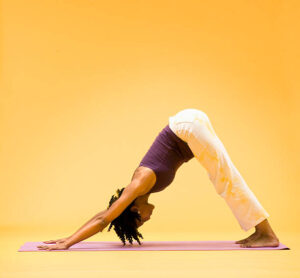Index of Contents
ToggleIntroduction
Yoga is an ancient practice that originated in India over 5,000 years ago. It combines physical postures and poses (asanas), breathing techniques (pranayama), and meditation or relaxation. Yoga has become increasingly popular around the world for its many health benefits.
Joint pain is very common and affects millions of people. It can be caused by many conditions like osteoarthritis, rheumatoid arthritis, injuries, overweight, normal wear and tear from aging, etc. The most common symptoms are pain, stiffness, swelling, tenderness, decreased range of motion, creaking, and inflammation around the joints. Joints most impacted are the knees, hips, lower back, neck, shoulders and hands.
Joint pain from arthritis or inflammation in joints can range from mildly irritating to debilitating. It may come and go, be constant, or get worse over time. Finding ways to manage and reduce joint pain is important for maintaining mobility and quality of life. Yoga is one approach that many have found effective in decreasing joint pain and associated symptoms.
Causes and Symptoms of Joint Pain
Joint pain can originate from a variety of sources, ranging from acute injuries to chronic inflammatory conditions. Understanding the root cause is key to finding the right treatment approach. Here are some of the most common culprits behind joint stiffness, swelling, and discomfort:
Joint Injuries
Trauma from sports, falls, or accidents can damage structures like ligaments, tendons, and cartilage. Tears and inflammation lead to instability, immobility, and pain. Knees, ankles, and shoulders are frequent sites of injury.
Aging
As we get older, cartilage can deteriorate and lose its shock absorbing capacity. This osteoarthritis causes bone-on-bone friction and stiffness. Pain and swelling are most common in weight-bearing joints like hips, knees, and lower back. Range of motion decreases over time.
Autoimmune Disorders
Diseases like rheumatoid arthritis cause the immune system to attack healthy joint tissues. This leads to inflammation, swelling, and eventual joint destruction if left untreated. Joints appear red, feel warm, and are tender.
Sedentary Lifestyle
Lack of movement allows joints to become stiff and muscles to atrophy. This reduces stability and shock absorption. When inactive people do engage in exercise, their joints are more prone to injury and pain due to lack of conditioning.
How Yoga Can Help with Joint Pain
Yoga is an excellent way to address joint pain, stiffness, and inflammation through gentle stretching, strength building, and pain relief. The slow mindful movements and poses in yoga are designed to improve flexibility and range of motion. Over time, a regular yoga practice can help lubricate joints, strengthen the muscles around the joints, and reduce inflammation.
Certain yoga poses can target problem areas in the body that are prone to pain and stiffness, such as the knees, hips, back, neck, wrists, and shoulders. Poses like Child’s Pose, Cat-Cow, and Forward Folds gently stretch tight muscles and joints. Strengthening poses like Warrior and Tree Pose improve stability around the joints. Twists massage the tissues around the joints and stimulate circulation.
Yoga also teaches breathing techniques that can help relax the body and turn down the nervous system’s pain response. Deep conscious breathing during yoga sends messages to the brain to release natural pain-relieving hormones like endorphins. Being present during yoga can shift the mind away from focusing on the pain. Over time, yoga helps reduce the perception of pain and discomfort in the body.
The combined benefits of increased flexibility, strength, pain relief, and anti-inflammatory effects make yoga an excellent natural therapy for joint issues. A gentle regular yoga practice can help people manage joint pain and stiffness for improved comfort, mobility, and quality of life.
Yoga Poses For Joint Pain
Certain yoga poses target the parts of the body impacted by joint pain. Focusing on these poses can strengthen muscles, increase flexibility, foster mindfulness, and relieve pain and tension in those areas. Some recommended yoga poses for joint pain relief include:

-
- Cat/Cow Pose – Moving between cat and cow pose gently mobilizes the spine and hip joints. It stretches the hips, abdomen, and back to promote flexibility and relieve stiffness.
-
- Child’s Pose – This resting pose gently stretches the hips, thighs and ankles. It helps alleviate back pain and tension. Child’s pose extends the spine and relaxes the lower back muscles.
-
- Bridge Pose – Bridge pose strengthens and stretches muscles around the spine, hips, and knees. It opens up the chest and shoulders while providing a gentle backward bend to relieve compression in the spine.
-
- Warrior I & II – The warrior poses strengthen the legs and stretch the hips, groin and chest muscles. This improves stability in the hips and knees while opening up the hips and shoulders.
-
- Tree Pose – Tree pose improves balance while stretching the inner thighs, hips, and chest. It strengthens the ankles and legs which help stabilize the knee joint. The concentration required also helps take the focus off joint pain.
These yoga poses help stretch and strengthen key muscles and joints impacted by pain and stiffness. A gentle yoga practice incorporating these postures can provide natural joint pain relief over time. Always listen to your body and avoid poses that cause sharp joint pain.
Yoga’s Anti-Inflammatory Effects
One of the primary ways yoga helps relieve joint pain is by reducing inflammation. Studies have found that practicing yoga consistently can reduce inflammatory markers like cytokines and C-reactive protein (CRP). Cytokines are small proteins released by various cells that signal inflammation. CRP is produced by the liver and is a marker of systemic inflammation.
Researchers believe yoga reduces inflammation through its effects on the body’s stress response and immune system. Yoga helps switch the nervous system into the parasympathetic “rest and digest” mode, dampening the release of cortisol and other stress hormones that trigger inflammation. Yoga postures, breathing exercises, and meditation also boost immune function by increasing circulation and white blood cell activity. A stronger immune system helps prevent excessive inflammatory responses.
Numerous studies confirm yoga’s anti-inflammatory powers. One randomized trial found just 10 weeks of yoga led to significant reductions in inflammatory cytokines like interleukin-6 (IL-6) and tumor necrosis factor-alpha (TNF-α). Another 12-week study showed subjects who practiced yoga had decreased CRP levels and pro-inflammatory cytokine production compared to non-yoga control groups. The anti-inflammatory benefits of yoga likely accumulate over time with consistent practice. Lowering inflammation is key to relieving joint discomfort and may help prevent or slow the progression of inflammatory arthritis.
Yoga Increases Flexibility
Regular yoga practice can help improve joint flexibility and range of motion. As we age, the tissues around the joints tend to lose elasticity and become stiff. The gentle stretching and range-of-motion exercises in yoga serves to lubricate the joints and warm up the surrounding muscles.
Over time, the continued practice of yoga asanas can help improve elasticity in the muscles, tendons, and ligaments. By moving the joints through their full range of motion, yoga helps “grease the groove” so joints can move more freely.
Certain types of yoga like hatha and vinyasa flow are particularly helpful for flexibility. Poses like the cat-cow, downward dog, and bridge pose gently take the joints through their full range of motion. Over time, this increased range of motion can help reduce joint stiffness and pain.
Yoga’s flexibility benefits include:
-
- Increased range of motion and joint lubrication
-
- Reduced stiffness in muscles and joints
-
- More freedom of movement
-
- Warm up of muscles and joints before other exercise
-
- Possible reduction of injury risk from tight muscles
By improving flexibility through yoga, people with joint pain and stiffness may gradually regain a wider range of motion and fluidity of movement.
Yoga Strengthens Muscles
Certain yoga poses help strengthen the muscles that support and stabilize the joints, which can relieve pain and improve mobility. When the muscles surrounding a joint are weak or tight, it can throw off alignment and put more stress on the joint.
Poses like Warrior I, Warrior II, Side Angle Pose, and Triangle Pose target the muscles of the legs and hips. Plank Pose, Four-Limbed Staff Pose, and Downward Facing Dog work the arms and core muscles. Sustained holds in these poses build strength in the muscle groups that support proper joint alignment.
Stronger muscles take some of the burden off sore joints. They also stabilize joints and improve balance and control of movements. With regular practice, yoga can rebuild lost muscle mass from reduced activity due to joint pain. Increased strength and stability reduces the risk of injury and joint damage.
By combining poses that target all the major muscle groups, a yoga practice provides a joint-friendly strengthening workout. The combination of gentle stretching and targeted muscle strengthening offers a natural way to support joint health.
Mind-Body Benefits
In addition to the physical benefits, yoga also provides mind-body benefits that can help improve joint pain.
One of the main mind-body benefits of yoga is that it reduces stress and anxiety. The meditation, breathing techniques, and mindfulness involved in yoga help calm the nervous system. This reduces the production of stress hormones like cortisol that can increase inflammation and worsen joint pain.
Yoga also improves pain tolerance. One study found that just 8 weeks of yoga substantially increased pain tolerance among people with rheumatoid arthritis (RA). The researchers theorized this was due to a combination of the physical improvements in flexibility as well as psychological factors like reduced stress and anxiety.
The mindfulness aspect of yoga teaches people to focus on the present moment. This can help take their mind off the pain and discomfort they may be experiencing. Mindfulness may also change people’s relationship and perception of the pain so that they suffer less. Instead of struggling against the pain, yoga helps people cultivate awareness, acceptance, and inner peace.
The combined physical and mental benefits of yoga make it a powerful therapy for improving joint health and reducing associated pain and inflammation. The mind-body connection and holistic approach of yoga sets it apart from other forms of exercise and makes it uniquely effective for people suffering from chronic joint issues.
Additional Lifestyle Tips
In addition to yoga, other lifestyle factors can help relieve joint pain and inflammation.
Diet
Eating an anti-inflammatory diet high in fruits, vegetables, whole grains, beans, lentils, nuts and omega-3 fatty acids can reduce inflammation. Limiting processed foods, refined carbs, saturated fats and red meat is also recommended.
Exercise
Low impact aerobic exercise like walking, swimming or biking can improve joint mobility. Strength training to build muscles around the joints adds support. Always check with your doctor before starting a new exercise program.
Stress Management
Chronic stress can increase inflammation and pain sensitivity. Try yoga, meditation, deep breathing or journaling to better manage stress levels. Getting enough sleep is also key.
Massage
Massage can help relieve muscle tension around painful joints. Work with a massage therapist who has experience with joint related conditions. Self-massage using a foam roller or tennis ball can also provide relief.
Supplements
Some supplements like glucosamine, chondroitin, turmeric, ginger and fish oil may help reduce joint inflammation and provide pain relief. As always, consult your doctor before trying new supplements, especially if you have other medical conditions.
Conclusion
Yoga offers numerous benefits for those suffering from joint pain, stiffness, and inflammation. This gentle practice can help relieve symptoms, increase flexibility and strength, and provide mental health benefits.
The slow mindful movements and various poses help lubricate the joints, reducing pain and inflammation. Holding poses like Warrior and Downward Dog gently strengthen the muscles surrounding the joints, improving stability and function over time. Breathing exercises also promote relaxation, lowering stress hormones that contribute to inflammation.
For those new to yoga, it’s best to start slowly with beginner floor poses and sun salutations a few days per week. Focus on proper alignment, never force your body into painful positions. Over time, you may work up to more challenging poses as your body adapts and becomes more flexible. But listening to your body and avoiding injury is key.
In summary, a regular yoga practice can be extremely beneficial for joint issues. Along with medication and other treatments your doctor recommends, yoga is an excellent complementary therapy to help you move with greater comfort and ease. Just be sure to find an instructor experienced with modifications for joint conditions. With a gentle, mindful approach, yoga can make a world of difference.



